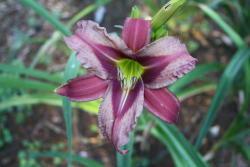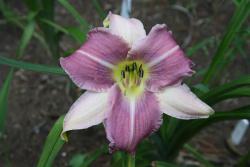Seedfork said:So for example if I want to focus on growing sculpted relief blooms I should focus on that. But I might want tall plants, large blooms, lots of blooms, lots of scapes, rust resistance, dark foliage, heat tolerant, pest resistant...it can just go on and on and still my main goal to be focused on would be sculpted relief blooms.
I think anyone hybridizing daylilies needs to know why they are hybridizing.
I am going to use an interest in growing sculpted relief blooms as an example.
If one checks the AHS database and selects sculpted relief for display there are 234 registered cultivars. If one adds that the bud count must be more than 20 then the number is reduced to 53 cultivars and if one changes that to more than 30 buds then there are only 11 cultivars. A search for scape heights of at least 30 inches and bud counts of at least 25 produces a listing of 14 cultivars.
A next question might be, are there cultivars already available that meet the requirements?
In the list of sculpted relief cultivars with more than 30 buds there are 11 cultivars listed with these flower colours - yellow gold (2), apricot sorbet, baby pink, yellow-orange-pink, honey and lime gold, gray purple, yellow cream, light purple, cream, purple blend. So if I was interested in growing a red flowered sculpted relief with at least 30 buds I would need to produce it myself. But if I was interested in purple flowered sculpted relief I might only need to purchase one of the registered cultivars and then determine if it was rust resistant, heat tolerant, etc.
If I wanted a red flowered sculpted relief with at least 30 buds then I have a decision to make about the red parent. Do I choose a sculpted relief with less than 30 buds or do I choose a cultivar with more than 30 buds but not sculpted relief? Do I choose several different unrelated red daylilies? If so, how many?
Lets say I choose to use a red sculpted relief but find that there is only one that matches what I am looking for in the colour but it has only 18 buds. No matter which of the cultivars with 30 buds I choose to use with this red the seedlings can be expected to average 24 buds. There will be seedlings with more than 24 buds and there will be seedlings with less than 24 buds. But the number of seedlings with at least 30 buds will only be a fraction of all the seedlings. And that assumes that the 30 bud parent breeds as if it is genetically 30 buds and the 18 bud parent breeds as if it is genetically 18 buds. They may breed as less (or they may breed as more). So the more seedlings I grow from the cross the better the chance that I find a seedling with at least 30 buds, sculpted relief and red-flowered. I do not need to produce all the seedlings in one year. I can make the cross in as many years that I want until I find a seedling that I like.
If one is hybridizing because one has definite, specific goals then depending on how extreme those goals are in comparison to what is currently available will shape how many seedlings need to be grown and often how many different crosses need to be made.
On the other hand, if one is hybridizing for enjoyment "to see what happens" and the goals are not fixed then the number of seedlings and the number of different crosses is not so important.
Daylilies are outcrossing so they do not generally breed "true". That makes it more difficult to choose parents. In general one should probably choose to make crosses with several different parents rather than just one cross. At least initially trying more parents and a smaller number of seedlings from each cross allows one to see if a particular cross is more effective at producing seedlings that may match the goals. One can then concentrate on such crosses and produce more seedlings from them in later years.

